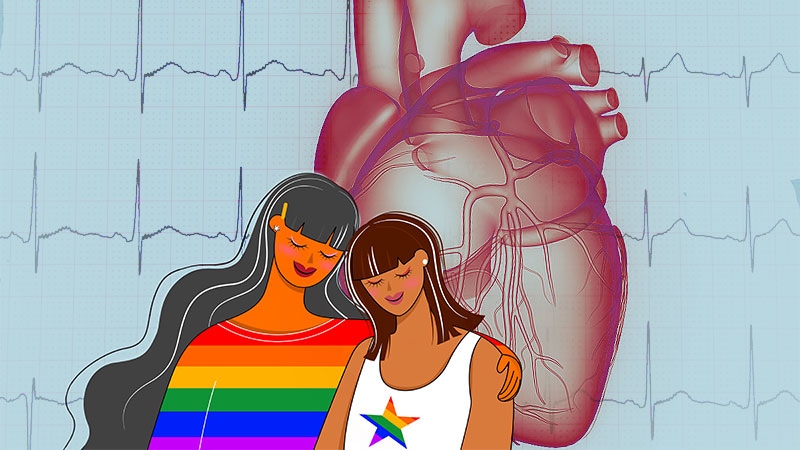Lesbian and Bisexual Women's Cardiovascular Health Disparities
Core Concepts
Lesbian and bisexual women have lower cardiovascular health scores compared to heterosexual women, emphasizing the need for targeted prevention strategies.
Abstract
The research highlights disparities in cardiovascular health among sexual minorities, emphasizing the importance of tailored prevention strategies. The study evaluated CV health using the AHA Life's Essential 8 checklist, revealing lower scores for lesbian and bisexual women compared to heterosexual women. Gay and bisexual men in urban areas showed better heart health, while those in rural areas had lower scores. The findings underscore the need to address healthcare access barriers for sexual-minority groups to improve CVD prevention and care provision.
Lesbian, Bisexual Women Less Likely to Have Ideal CVD Health
Stats
Among women, lesbian and bisexual individuals had significantly lower CV health scores compared to heterosexual women.
Gay and bisexual men had higher CV health scores than heterosexual men, especially in urban areas.
Lesbian women who were ever pregnant had higher CV health scores compared to heterosexual women.
Quotes
"Improving these metrics is a great opportunity to prevent heart problems before they happen." - Omar Deraz, MD
Key Insights Distilled From
by Megan Brooks at www.medscape.com 05-25-2023
https://www.medscape.com/viewarticle/992460
Deeper Inquiries
How can healthcare access barriers for sexual-minority groups be effectively addressed to improve CVD prevention?
Healthcare access barriers for sexual-minority groups can be effectively addressed through several strategies. Firstly, healthcare providers need to undergo training to increase their cultural competency and sensitivity towards sexual-minority individuals. This training should focus on understanding the unique healthcare needs and challenges faced by this population. Additionally, creating safe and inclusive healthcare environments where sexual-minority individuals feel comfortable disclosing their sexual orientation is crucial. This can be achieved by implementing nondiscrimination policies and providing education to staff on LGBTQ+ health issues.
Furthermore, increasing access to healthcare services tailored to the needs of sexual-minority individuals is essential. This includes offering LGBTQ+ affirming care, providing resources for mental health support, and ensuring access to preventive services such as cardiovascular screenings. Outreach programs targeting sexual-minority communities can also help bridge the gap in healthcare access by providing information on available services and resources.
What factors contribute to the disparities in cardiovascular health between sexual minorities and heterosexual individuals?
Several factors contribute to the disparities in cardiovascular health between sexual minorities and heterosexual individuals. One key factor is the presence of social determinants of health, such as discrimination, stigma, and minority stress experienced by sexual-minority individuals. These factors can lead to higher levels of chronic stress, which in turn can impact cardiovascular health.
Moreover, sexual-minority individuals may face barriers to healthcare access, including lack of insurance coverage, limited access to LGBTQ+ affirming healthcare providers, and fear of discrimination in healthcare settings. This can result in delays in seeking preventive care and treatment for cardiovascular conditions.
Additionally, lifestyle factors such as smoking, poor diet, and lack of physical activity may also contribute to the disparities in cardiovascular health among sexual minorities. Addressing these factors through targeted interventions and education can help improve cardiovascular outcomes in this population.
How can research into underrepresented populations like sexual minorities be further encouraged and supported?
Research into underrepresented populations like sexual minorities can be further encouraged and supported through various means. Firstly, funding agencies and research institutions should prioritize and allocate resources for studies focusing on LGBTQ+ health disparities. This can include specific grant opportunities for researchers studying sexual-minority populations and their unique health needs.
Collaboration between researchers, community organizations, and advocacy groups can also help facilitate research into sexual minorities by providing access to study participants and promoting community engagement. By involving sexual-minority individuals in the research process, studies can be more reflective of their experiences and needs.
Furthermore, increasing visibility and representation of sexual minorities in research publications and academic conferences can help raise awareness of LGBTQ+ health disparities and the importance of studying this population. By promoting diversity and inclusion in research settings, we can ensure that the health needs of all individuals, including sexual minorities, are addressed and prioritized.
0
